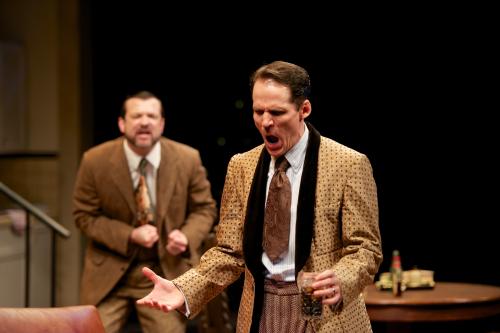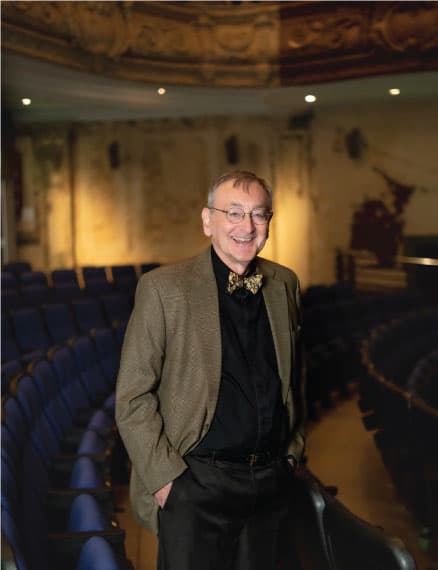Likeable Frenemies in St. Germain’s SCOTT AND HEM at CATF
Posted on BroadwayWorld July 12, 2013
“Every good story’s a war story,” says a character in Scott and Hem in the Garden of Allah, premiering at the Contemporary American Theater Festival. That certainly seems to be playwright Mark St. Germain‘s approach in imagining a 1937 encounter between writers F. Scott Fitzgerald and Ernest Hemingway.
Some history first. Such an encounter could have happened; Fitzgerald was in Hollywood living in an apartment complex called the Garden of Allah and writing for MGM in 1937. Hemingway did come through town that summer for screenings of Hemingway and John Dos Passos‘ documentary about the Spanish Civil War, The Spanish Earth. It appears Fitzgerald attended one screening, and sent a complimentary note to Hemingway afterwards. But the fact that he had to send a note suggests the distance between the writers. They had been much in each other’s company in 1925-26 and again in the spring of 1929, and then, after that, only on about seven more occasions over the rest of their lives. As Fitzgerald wrote toward the end of his life, he and Hemingway had “not [been] really friends since 1926.”
Perhaps the best label for what they had been since 1926 is “frenemies.” And hence the “war story” St. Germain constructs for them. In St. Germain‘s conception, they remain competitors, though their career trajectories are both heading downwards at this point. Fitzgerald’s last complete novel (and this is factual) is behind him, Hemingway (Rod Brogan) is too far into wives and bottles and losing his talent (a lot more of a stretch, considering that he would go on to write For Whom the Bell Tolls and The Old Man and the Sea yet), and Hemingway comes to Fitzgerald (Joey Collins) with a plan to rescue Fitzgerald from oblivion by giving him the movie rights to The Snows of Kilimanjaro to sell. But of course this offer may be a Trojan Horse of sorts, a way to make Fitzgerald less hungry and less of a competitor for literary glory.
And in a sense that’s it, that’s the play. The dramatic issues posed by the play are ones whose outcomes most viewers will know: whether Scott kicks his alcoholism, whether Hemingway kicks his, whether Scott accepts Hemingway’s Trojan Horse, whether Scott can ultimately succeed as a screenwriter. So the dramatic tension is not as high as it might be in a different kind of play.
I wrote in another publication concerning St. Germain‘s recent off-Broadway hit Freud’s Last Session that it wasn’t so much that anything happened in the play, but that it was C.S. Lewis being C.S. Lewis and Freud being Freud, and that that was enough to make the play worthwhile. And, given the lack of dramatic tension in the current play (even when the characters do take a couple of swings at each other to liven things up), the same basic proposition, Fitzgerald being Fitzgerald and Hemingway being Hemingway, is the ultimate value added of Scott and Hem. I’m not certain whether this time the formula works as well.
One of the things that bothers me is all the offstage cameos, smuggled in by, among other things, mentions of who was at the screening of Hemingway’s movie, and by the presence at a party below the apartment and interacting with Fitzgerald through an Open Window, of a great many Hollywood notables, Erroll Flynn, Robert Benchley, Tallulah Bankhead, Dorothy Parker, Frederick March, and Charles Laughton among them. They seem to have be brought in partly for verisimilitude (yes, we really are in Hollywood in 1937!) but also, I think, to impart a little thrill to the scene we are watching, to make us feel as if we are in the presence or at least the vicinity of many more interesting people than just the two right in front of us. It betrays a certain insecurity on St. Germain‘s part as to whether he’s got enough going on in this play with just the two right in front of us.
In the end, I think it’s barely enough. I repeat: we really don’t care too much about the action of the play, because if we have any biographical clue about the subjects we kind of know where it must go, and in any event St. Germain takes some nearly Shakespearean liberties with the facts. (For instance, Fitzgerald was let go by MGM in 1939, not 1937, and went on writing as a freelance screenwriter for the rest of his life, which gives the lie to the meaning, not just the facts, of an ending which suggests he is washed up in Hollywood.) But an evening just taking in the company of these two booze-afflicted geniuses left me feeling entertained if not thrilled.
And certainly the cast did its part to make the evening pass pleasantly. Collins and Brogan look and act close enough to my conceptions of Hemingway and Fitzgerald to pass muster, and their achievement is the more remarkable when one realizes that they are simultaneously holding down major and very different roles in A Discourse on the Wonders of the Invisible World, playing in repertory at the Contemporary American Theater Festival (reviewed here), and are often scheduled to do both plays on a single day. (For Collins, this reprises his feat of last season, when he alternated between roles as a ne’er-do-well U.S. college town handyman and an Israeli secret agent.) And I was tremendously impressed by Angela Pierce in a medium-sized role as “Miss Montaigne,” who seems to be some kind of amalgam of studio functionary and Sheilah Graham, a historical Fitzgerald girlfriend of this era. As Fitzgerald’s minder morphing into his lover, she combines steely determination, killer appearance (doing the 30s pencil skirt, stockings and tight sweater look), and an independence of spirit as a woman making her way in a men’s workplace; she could be Peggy Olson’s much older sister.
In a festival bristling with difficult and challenging plays, this is the easygoing exception, interesting and likeable. And that is fine. Not every surface has to be sandpaper.
Copyright (c) Jack L. B. Gohn except for production still


 I lived in London and Vienna before coming to the United States, and grew up mainly in Ann Arbor. I was writing plays and stories as early as grade school. My undergraduate years at the University of Pennsylvania, where I first reviewed theater, for the college paper, were succeeded by graduate study at the Johns Hopkins University, where I earned a doctorate in English Literature.
I lived in London and Vienna before coming to the United States, and grew up mainly in Ann Arbor. I was writing plays and stories as early as grade school. My undergraduate years at the University of Pennsylvania, where I first reviewed theater, for the college paper, were succeeded by graduate study at the Johns Hopkins University, where I earned a doctorate in English Literature.